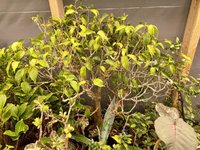hemmy
Omono
Has anyone experienced nutrient deficiencies growing ficus under full spectrum LED?
On the tail end of my first indoor ficus season and hope to have to them all outdoors in a few weeks. But it was not without challenges!
Scale and whitefly were persistent. Soaps didn’t cut it and I had to use a neonictinoid.
I wasn’t acidifying my hard water or fertilizing until the last several weeks.
My largest are Ficus microcarpa mostly working on secondary branching. But I lost a lot of smaller branching on a F. microcarpa in a shallow box (red circle) and a F. benjamina in a bonsai pot (red circle). Both of these were the better trees and kept under the lights (300W, SE3000, Spider Farmer (back when they were slightly more affordable in the early Fall)). I would move the lights around somewhat, but I’m noticing that the F. microcarpa that gets the most light has lost color and branches (red circle). It also dries out quickly. The same variety ficus next to it in a large nursery can (blue circle) is a much deeper green with more leaves.
I have a hard time thinking the light intensity was too much for a ficus, but maybe I wasn’t keeping them wet enough for the higher transpiration rates. That combined with nutrient lock in the substrate from drying out and harder water.
I was hoping to get it corrected before they went out so I’d be more confident going into next Fall. But acidifying the water and weekly miracid hasn’t done much. Any advice is appreciated.
Cheers!





On the tail end of my first indoor ficus season and hope to have to them all outdoors in a few weeks. But it was not without challenges!
Scale and whitefly were persistent. Soaps didn’t cut it and I had to use a neonictinoid.
I wasn’t acidifying my hard water or fertilizing until the last several weeks.
My largest are Ficus microcarpa mostly working on secondary branching. But I lost a lot of smaller branching on a F. microcarpa in a shallow box (red circle) and a F. benjamina in a bonsai pot (red circle). Both of these were the better trees and kept under the lights (300W, SE3000, Spider Farmer (back when they were slightly more affordable in the early Fall)). I would move the lights around somewhat, but I’m noticing that the F. microcarpa that gets the most light has lost color and branches (red circle). It also dries out quickly. The same variety ficus next to it in a large nursery can (blue circle) is a much deeper green with more leaves.
I have a hard time thinking the light intensity was too much for a ficus, but maybe I wasn’t keeping them wet enough for the higher transpiration rates. That combined with nutrient lock in the substrate from drying out and harder water.
I was hoping to get it corrected before they went out so I’d be more confident going into next Fall. But acidifying the water and weekly miracid hasn’t done much. Any advice is appreciated.
Cheers!












